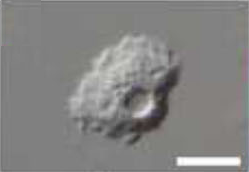Morphology
Luapeleamoeba are uninucleate amoebae that, during locomotion, generate a single broad, hyaline lamellipodium with inferior triangular pseudopodia at the edge directing the movement. Behind the lamellipodium there's a thick region of cytoplasm with granules containing a contractile vacuole usually posterior to the single nucleus. There is a big nucleolus with a diameter at least half of the nucleus' diameter. There is a centrosomal region near the nucleus with a Golgi apparatus, other vesicles, and an electron-dense lamellate microtubule-organizing center, which is visibly smaller and less lamellate than those seen in other acanthamoeboid genera. The amoeba is thickest near the contractile vacuole and the nucleus, and tapers gradually toward the edges, giving the overall appearance of a small shield volcano. The floating form is round, although not smooth. No flagella have been seen. The cysts are rare. They can form fruiting bodies. [2]
This page is based on this
Wikipedia article Text is available under the
CC BY-SA 4.0 license; additional terms may apply.
Images, videos and audio are available under their respective licenses.

